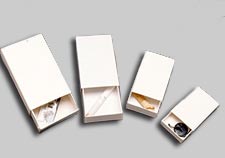Home | Glossary | Resources | Help | Contact Us | Course Map
Archival Notice
This is an archive page that is no longer being updated. It may contain outdated information and links may no longer function as originally intended.
Collection of Evidence
The evidence examined by a crime laboratory originates at a crime scene. It may be identified and collected directly at the scene or through subsequent examination of persons or items related to the crime scene.
Evidence identified and collected directly at a scene may include
- blood spatters on a wall,
- equipment and chemicals at a clandestine drug laboratory,
- cartridge cases at a shooting.
Evidence identified and collected following examination of persons or items taken from the scene may include
- body fluids from a rape/homicide victim,
- latent prints on a weapon,
- hairs and fibers on clothing.
Firearms Evidence
The collection of firearms includes the firearm, ammunition, and associated materials, such as clothing with gunshot residue deposits.
Firearms
Firearms should be unloaded and placed in a safe condition at the point of collection. If the collector is unsure of the proper procedure, assistance should be sought from a competent source such as a firearms instructor, departmental armorer, or an on-site firearm examiner.
The firearm should be identified at a minimum with the information required by the agencys crime scene search protocols. If agency protocols mandate the direct marking of evidence, the firearm should be marked inconspicuously. One method is to inscribe the collectors initials and other required information within the trigger guard of the firearm. A diamond or tungsten-tipped machinists scribing tool is frequently used for this purpose. Laboratory protocols should be followed for firearms recovered from water since special handling may be required.
Collected firearms should be packaged according to laboratory or agency policy, for example by sealing in unused wrapping paper and placing in a cardboard box designed for either handguns or shoulder arms. Unloaded ammunition may be packaged separately, marked, and identified as to the firearm from which it was removed.
Fired Bullets
Fired bullets are frequently found at crime scenes and after shooting incidents; they may be found on the floor, in walls, floors, ceilings, mattresses, and inside electrical appliances.
If the number of fired cartridge cases exceeds the number of bullets found in the victim(s), this indicates that a further search for remaining bullets may be necessary. If the number of bullets appears to exceed the number of cartridge cases, this may indicate that some of the bullets may be fragmented.
Bullets are frequently received from medical examiners during or after autopsies. Medical examiners should be knowledgeable in the proper packaging of evidence and chain-of-custody requirements.
Each jurisdiction has specific protocols for marking fired bullets and fragments. Some jurisdictions require that only the packaging should be marked; others require that the items are also marked. If agency protocols mandate the direct marking of evidence, a metal scribe should be used to mark the base of the projectile. Marking the nose area may disturb or cause the loss of trace evidence. The bearing surface of an evidence bullet should never be marked as this is the area critical to the identification process. It may not be possible to properly mark mutilated bullets.
To limit damage and to preserve the unique microscopic marks that they bear, fired bullets should be placed in separate pasteboard boxes or plastic containers along with any apparently related fragments. Within the container, the bullet should be wrapped in a small amount of unused wrapping paper to preserve any trace evidence that may be present.
Other materials, such as envelopes, may be used to package fired bullet evidence.
Fired Cartridge Cases and Shotshells
Fired cartridge cases and shotshells are most often found at incidents involving semiautomatic and full automatic weapons.
If agency protocols mandate the direct marking of evidence, a metal scribe should be used to mark inside the mouth of the cartridge case or on the side of the case, near the mouth. Fired shotshell cases should be marked at the metallic base, where the base joins the plastic or fiber body. Plastic shotshells can be scribed in the thick plastic area near the base. Markings made with permanent markers tend to fade after normal handling in the laboratory. Agency protocol should always be followed, and evidence should not be marked directly unless specifically mandated.
Recommended packaging for fired cartridge cases and shotshells is similar to bullets. To protect the microscopic marks on these fired components, the cartridge cases and shotshells should be packaged separately to prevent them from striking each other.
Unfired Ammunition
Unfired ammunition has evidentiary potential and should be collected, marked, and packaged in a manner similar to fired cartridge cases and fired shotshells. Cartridges that are cycled through the action of a firearm may bear extractor and ejector marks identifiable with a specific firearm and should be collected for forensic examination.
Additional Online Courses
- What Every First Responding Officer Should Know About DNA Evidence
- Collecting DNA Evidence at Property Crime Scenes
- DNA – A Prosecutor’s Practice Notebook
- Crime Scene and DNA Basics
- Laboratory Safety Programs
- DNA Amplification
- Population Genetics and Statistics
- Non-STR DNA Markers: SNPs, Y-STRs, LCN and mtDNA
- Firearms Examiner Training
- Forensic DNA Education for Law Enforcement Decisionmakers
- What Every Investigator and Evidence Technician Should Know About DNA Evidence
- Principles of Forensic DNA for Officers of the Court
- Law 101: Legal Guide for the Forensic Expert
- Laboratory Orientation and Testing of Body Fluids and Tissues
- DNA Extraction and Quantitation
- STR Data Analysis and Interpretation
- Communication Skills, Report Writing, and Courtroom Testimony
- Español for Law Enforcement
- Amplified DNA Product Separation for Forensic Analysts




